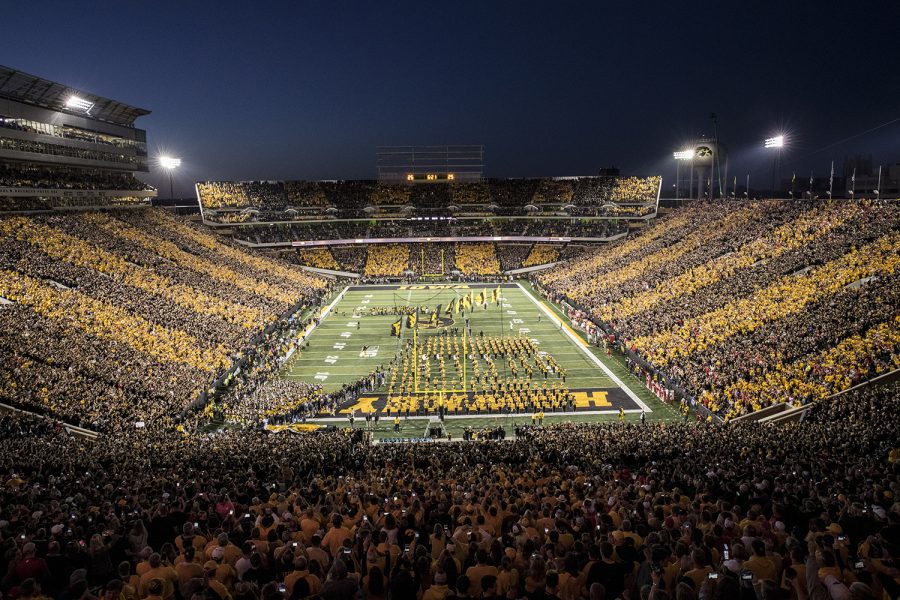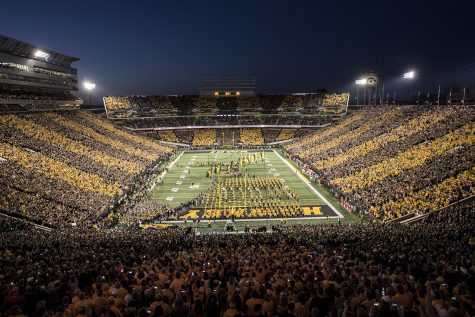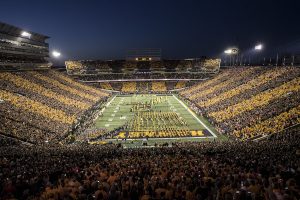UI athletics revenue down despite boost in Big Ten support
UI athletics revenue has fallen despite increased Big Ten support.
The Hawkeyes take the field before their game against Wisconsin at Kinnick Stadium on Saturday, September 22, 2018. The Badgers defeated the Hawkeyes 28-17.
November 16, 2018
University of Iowa athletics revenue was below expectations for the last budget year with season and individual ticket sales on the decline for men’s sports.
Total athletics revenue was $839,911 less than the budgeted $117.1 million, according to the state Board of Regents’ fiscal 2018 report. The decrease in athletics revenue comes despite increased Big Ten contributions and was particularly visible in men’s sports revenue.
Men’s sports revenue for fiscal 2018 came in at $25.4 million, $2.3 million less than budgeted for that year, according to the report.
Revenue for women’s sports came in $94,747 above what was expected. Nonrevenue women’s sports, such as rowing and field hockey, had success despite the general decline in athletics revenue.
UI Athletics Director Gary Barta said in a previous interview with The Daily Iowan that the success of nonrevenue sports can be attributed to extensive budgetary planning.
RELATED: UI Athletics to contribute funds to advance university initiatives
“I always say to our staff, ‘Hope is not a strategy,’ so we always have been planning,” Barta said. “The thing about it is, you can’t just flip a switch. With [nonrevenue sports], we sit down, and we do a full review of each sport; we look at their facilities, we look at their budgets, we look at their coaching, we look at all the things that matter to make that program better.”
Iowa is ranked fifth in sports revenue among Big Ten schools, 18th overall, according to USA Today.
Athletics conference contribution has steadily increased since fiscal 2014, when Big Ten support was $26.4 million, according to regents’ documents. Since then, support jumped 98.9 percent to $52.6 million in fiscal 2018 — up from $36.1 million in fiscal 2017. The amount exceeded the budget “due to additional bowl income distributions.”
The Big Ten formally announced its six-year media-rights deals with CBS, Fox, and ESPN in 2017 — more than a year after the agreement was made — that is worth a reported $2.64 billion. The conference partners with Fox and ESPN to broadcast football games, and CBS holds rights to broadcast basketball games.
RELATED: Harreld: Should sports revenue be shifted into academics?
“… We have a pretty good Athletics Department, and, actually, their media rights are going up rather substantially with the Big Ten, so we’re reaching in there and grabbing some of that money to help the academic side of the institution,” UI President Bruce Harreld told the DI in May. “It’s a lot, and all of those are really important.”
The issue of athletics funding the academic side of the institution has come up in recent years, particularly as the state’s regent universities see their budgets cut because of lagging state support. In previous DI interviews, Harreld praised the Athletics Department for its monetary support of UI academics.
Barta told the DI in October the Athletics Department contributes slightly more than $20 million to the central campus, with $12 million going to scholarship support for student-athletes.
“In addition to [scholarship contributions], the most recent addition, we’ve now contributed $4 million over the past couple of years to the general fund, and we plan to do another $2 million this year, and we will do it as long as we’re able,” he said.
Barta also pointed out hat the Athletics Department is self-sustaining, unlike other university departments that receive student fees and state support.
“The Athletics Department’s budget is self-sustaining, so there are no general-fund dollars; there are no student fees,” Barta said. “It’s 100 percent generated by fans, and fundraising, and TV revenue.”




















